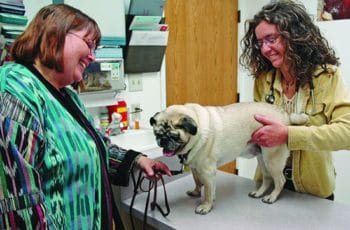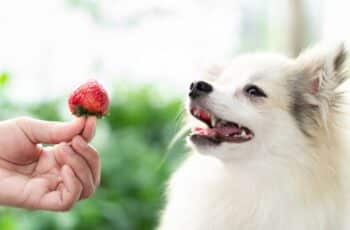The Lhasa Apso is an incredibly cute, dainty little pup whose personal demands on their pup parent tend to be more about good food, good grooming, and plenty of snuggles than extensive exercise and rambunctious games.
For some, especially those who live in an apartment or condo, this may make them an ideal choice. Roughly 15 to 20% of the population is allergic to animals, so for those who believe they may be allergic to pet fur and dander, the question “are Lhasa Apso Dogs hypoallergenic” is one they will need to be answered before welcoming such a pup into their home.
But some dog breeds, like the Lhasa Apso, not only usually produce fewer of these allergens – especially the Can f 1 allergen that researchers have determined is responsible for 75% of human allergic reactions to dogs – but have physical characteristics and behaviors that make them closer to hypoallergenic than many other dog breeds.
Many people believe they are allergic to the fur of dogs. So they would assume that the long-haired Lhasa Apso would be far from a pup that could be called hypoallergenic. However, this is not the case.
The naturally occurring allergens that cause an allergic reaction in humans to dogs are found in their saliva, dander (dead old skin), urine and sebaceous cells.
While that allergen does transfer to pups’ fur when they groom themselves, making it an allergen, a hairless dog is not the remedy for individuals allergic to dogs, contrary to popular belief. Instead, it’s quite a bit more complicated than that, as we’ll explain next.
Certain dogs can be less allergic than others but this is depends on the individual and his environment and cannot be foreseen.
Bear in mind, allergic symptoms can also arise from certain products in the home, like dust mites, pollen and molds and it is this cumulative allergen load alongside with pets that might worsen symptoms.
Does that mean that you cannot get or keep your pet? No, but you must put in the time and effort to decontaminate your home and find a pet that causes the least amount of pet dander and fur to limit your exposure to allergens.
As we mentioned, given that the Lhasa Apso has a long, silky coat it seems like an unlikely candidate to be a hypoallergenic dog breed.
But it is indeed considered to be one, and here are some of the most important reasons why:
1. Lhasa Apsos Don’t Drool
Some pups – like the Great Danes, Bulldogs and Golden Retrievers – are drool machines, and all that saliva is a problem for those allergic to dogs, as it will spread allergens all over the place: on the pup’s fur, on their bedding, on your carpets and floors, on your face if they lick you, you get the idea.
Lhasa Apsos barely drool at all, minimizing the amount of saliva they spread throughout their home environment.
2. Lhasa Apsos Don’t Shed Much
Even though they have all of that luxuriant fur, it’s smooth, silky fur, and Lhasa Apsos don’t shed a lot of it, and the breed is considered to be a part of the ‘low shedding’ category of dogs.
Less hair shed = fewer allergens.
3. Lhasa Apsos Are Small
The smaller any dog is, the fewer allergens it will leave behind in its wake. The average Lhasa Apso is 10-12 inches tall and 16-18 pounds when fully grown, which is also a reason they make great pets for dog-loving apartment dwellers: they don’t take up much space, and neither do their ‘belongings’, which can, of course, also harbor allergens.
4. Lhasa Apsos are Not Big on Exercise
As we mentioned earlier, as lively as they are – and the Lhasa Apso is often an energetic and excitable pup – they are not big on formal exercise, and for most a fifteen-minute walk a day is all they will happily tolerate. The less time they spend in places where other dogs go – like the dog park – the less likely it is that they will pick up allergens from them that they will then bring home!
As close to hypoallergenic as a Lhasa Apso is, they still carry those allergens, and so may still present a problem for those who are particularly allergic to dogs.
However, the good news here is that there are steps you can take that will minimize these reactions, often to the point that dog allergies are not an issue, or at least one that can be solved with the occasional antihistamine.
Decontaminating your pet and improving your immediate environment are the most effective ways if you suffer from pet allergies.
Here is a look at some of the most effective of these to help alleviate your symptoms:
Don’t Let Your Pup on Your Furniture
Yes, your pup is a part of your family, but if someone in your home is allergic to dogs then they should be discouraged from joining you on the couch, or making use of any of the furniture designated for humans.
This can be easier said than done, especially when it comes to Lhasa Apsos who can be notoriously stubborn. However, a good training program will be very helpful here (and Lhasas benefit from formal training anyway to help rid them of some of their less adorable tendencies.)
One excellent dog training program we can recommend for busy pet parents, who may not have the time to attend lots of formal in-person dog training classes is the Doggy Dan Online Dog Trainer Program.
Offered by Dan Abdelnoor, a New Zealand native known as one of the world’s foremost dog training experts, these online classes can be ‘taken’ whenever you and your pup have the time, and can help you train your pup to stay off your furniture and much more.
Don’t Allow Your Pup in Your Bedroom
If you are allergic to dogs your pup, even a hypoallergenic breed like a Lhasa Apso, should not be allowed into your bedroom, and should certainly not sleep there.
Many people who are allergy sufferers, in general, find that their allergies are worse at night, but maintaining a clean, ventilated, as allergen-free as possible sleeping space can help a lot.
Allowing your pup into that space will mean that you will not be able to achieve that.
Give Your Pup Their Own Space
If you are going to train your pup to stay off your furniture and out of your bedroom, you should, in return, offer them a comfortable space of their very own.
While you don’t have to buy them their own dog couch – although a Lhasa Apso might actually really appreciate it if you do – they should have a comfortable washable bed, and a formal dog toy box, in an area of your home they can call their own.
There are lots of good reasons for doing this, especially if you are allergic to dogs. Keeping all of your pup’s things in a single space restricts how far allergens are spread, and makes everything easier to clean (more on that in a moment.)
Having their own ‘bedroom’ makes it far less likely they will feel they need to try and invade yours and will also give them a safe space to retreat to when they feel overwhelmed or stressed by what’s going on around them, a common problem with Lhasa Apsos.
Use a Good Vacuum with a HEPA Filter
While it is not your pup’s fur that directly causes an allergic reaction, the saliva that is inevitably attached to it may, so regular vacuuming with a good pet vacuum is a must to keep any hair off the floor and out of the air.
Regular vacuuming is a great way to achieve this, and if you make use of a HEPA filter when you do so it will be even more effective HEPA – which stands for “high-efficiency particulate air – filters are considered to be far more effective than a standard vacuum filter, and are able to remove over 99% of the dust and allergens contained on or in your flooring, furnishings and the air.
Most vacuums can be fitted with them and they only cost a dollar or so more than standard filters.
While on the subject of HEPA filters you should also ensure you use them in your HVAC systems, as that will help keep your home dog allergen free too, while also extending the useful life of such systems, an added bonus.
Groom Your Pup Outside
A Lhasa Apso does not shed much, but they do have long hair and do need regular grooming.
Bathing your Lhasa at lease once a week using a vet recommended shampoo that won’t dry out their skin and wipe your pet using pet-safe wipes formulated to prevent dander.
Unless you can head to the grooming parlor every few days, which is a very impractical, and expensive idea, you will therefore need to brush their fur at home.
This should ideally always be done outside to minimize the spread of dander and allergens. If that’s not possible make sure that you designate a specific grooming spot that will be easy to clean up afterward, and that you store dog brushes in a sealed space – like a sealed holdall, drawer, or Ziploc bag – when they are not in use.


